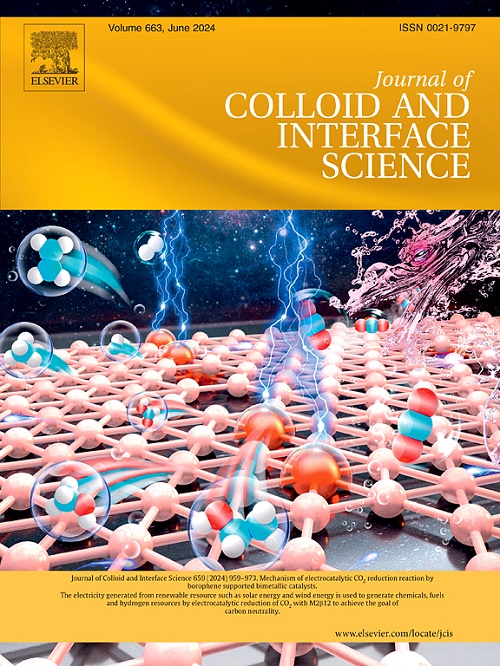纯和超分子复合凝胶上的小角和超小角中子散射
IF 9.7
1区 化学
Q1 CHEMISTRY, PHYSICAL
引用次数: 0
摘要
能够引发特定健康和疾病状态的高度复杂的组织工程模型的发展可能会彻底改变疾病治疗。为了实现这一目标,它需要产生高度复杂的水凝胶/生物材料系统,包括具有可调特性的材料和由不同尺寸范围的结构组成的多尺度结构。在开发这样的系统时,至关重要的是量化纳米和微米尺度范围内的任何结构和相互作用,以确定这些系统如何影响细胞表型。小角和超小角中子散射被用来量化两种生物材料的结构,这些材料以前用于组织工程技术。明胶甲基丙烯酰(GelMA)是一种常用的组织工程水凝胶,它的杨氏模量可以通过控制交联密度来调节。在这项工作中,中子散射表明,在9.1% w/v下,软凝胶(7.3 kPa±2.2 kPa),低交联的GelMA水凝胶和硬凝胶(30.5 kPa±3.5 kPa),高交联的GelMA水凝胶的网眼尺寸/纤维间距(4.7 nm - 4.5 nm)差异不大。然而,硬凝胶凝胶显示形成密集的高交联聚集体,大小为8.0 nm,而软凝胶凝胶中没有看到。研究人员还对新开发的复合水凝胶进行了中子散射,该复合水凝胶由GelMA(聚合物链半径0.7 nm)嵌入由n -庚基半内酯双层堆叠而成的超分子纤维组成。先前表征的纯半乳糖酰胺纤维被证实具有128 nm的厚度,可重复堆叠/双层厚度为3.7 nm。将如此大的半乳糖酰胺纤维掺入GelMA中不会导致GelMA网络的中断。本文章由计算机程序翻译,如有差异,请以英文原文为准。

Small and ultra small angle neutron scattering on pure and supramolecular composite GelMA hydrogels
Development of highly sophisticated tissue-engineered models capable of eliciting specific health and disease states could revolutionise disease treatment. To accomplish this it requires the generation of highly sophisticated hydrogel/biomaterial systems, including materials with tuneable properties and multiscale architecture composed of structures with different sizes ranges. In developing such systems, it is crucial to quantify any structures and interactions in the nano- and micron-scale range, to determine how these systems may affect cell phenotype. Small and ultra-small angle neutron scattering were used to quantify the structure of two biomaterials previously used in tissue engineering techniques. Gelatin methacryloyl (GelMA) is a commonly used hydrogel for tissue engineering and it has already been established that its Young's modulus can be tuned by controlling the crosslinking density. In this work, neutron scattering showed that there is little difference between the mesh size/fibre spacing (4.7 nm–4.5 nm) in 9.1 % w/v, soft (7.3 kPa ± 2.2 kPa), low crosslinked GelMA hydrogels and stiff (30.5 kPa ± 3.5 kPa), highly crosslinked GelMA hydrogels. However, stiff GelMA hydrogels showed the formation of dense highly crosslinked aggregates with a size of 8.0 nm that were not seen in the soft GelMA hydrogels. Neutron scattering was also performed on newly developed composite hydrogels consisting of GelMA (polymer chain radius 0.7 nm) embedded with significantly larger supramolecular fibres made from stacked bilayers of N-heptyl-galactonamides. Previously characterised pure galactonamide fibres were confirmed to have a thickness of 128 nm with a repeatable stacking/bilayer thickness of 3.7 nm. Incorporation of such large galactonamide fibres within the GelMA led to no disruption of the GelMA network.
求助全文
通过发布文献求助,成功后即可免费获取论文全文。
去求助
来源期刊
CiteScore
16.10
自引率
7.10%
发文量
2568
审稿时长
2 months
期刊介绍:
The Journal of Colloid and Interface Science publishes original research findings on the fundamental principles of colloid and interface science, as well as innovative applications in various fields. The criteria for publication include impact, quality, novelty, and originality.
Emphasis:
The journal emphasizes fundamental scientific innovation within the following categories:
A.Colloidal Materials and Nanomaterials
B.Soft Colloidal and Self-Assembly Systems
C.Adsorption, Catalysis, and Electrochemistry
D.Interfacial Processes, Capillarity, and Wetting
E.Biomaterials and Nanomedicine
F.Energy Conversion and Storage, and Environmental Technologies

 求助内容:
求助内容: 应助结果提醒方式:
应助结果提醒方式:


